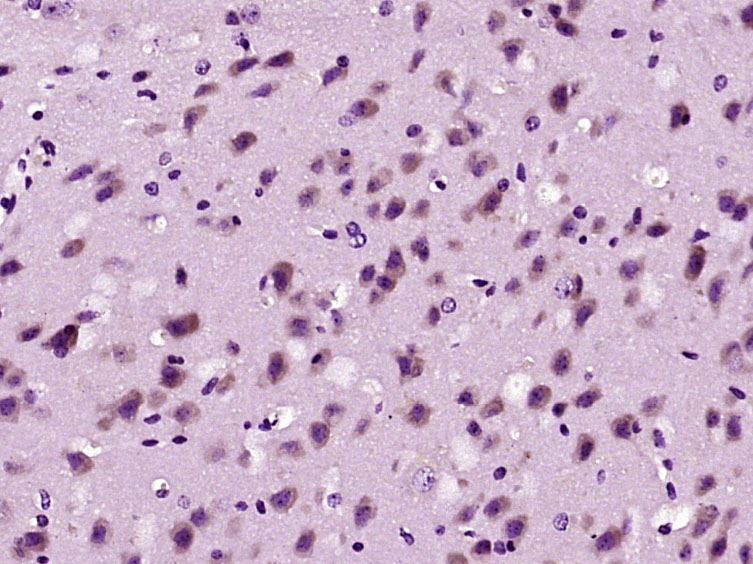
Rabbit Anti-CACNB3 antibody
CAB3; CACB3_HUMAN; CACNLB3; Calcium Channel Voltage Dependent Beta 3 Subunit; Calcium channel voltage-dependent subunit beta 3; FLJ58949; Voltage-dependent L-type calcium channel subunit beta-3.
View History [Clear]
Details
Product Name CACNB3 Chinese Name L型电压依赖型钙通道β3(L-type Ca++ CPβ3)抗体 Alias CAB3; CACB3_HUMAN; CACNLB3; Calcium Channel Voltage Dependent Beta 3 Subunit; Calcium channel voltage-dependent subunit beta 3; FLJ58949; Voltage-dependent L-type calcium channel subunit beta-3. Immunogen Species Rabbit Clonality Polyclonal React Species (predicted: Human, Mouse, Rat, Pig, Cow, Horse, Rabbit, Sheep, ) Applications ELISA=1:5000-10000 IHC-P=1:100-500 IHC-F=1:100-500 ICC=1:100-500 IF=1:100-500 (Paraffin sections need antigen repair)
not yet tested in other applications.
optimal dilutions/concentrations should be determined by the end user.Theoretical molecular weight 54kDa Cellular localization cytoplasmic The cell membrane Form Liquid Concentration 1mg/ml immunogen KLH conjugated synthetic peptide derived from human CACNB3: 101-200/484 Lsotype IgG Purification affinity purified by Protein A Buffer Solution 0.01M TBS(pH7.4) with 1% BSA, 0.03% Proclin300 and 50% Glycerol. Storage Shipped at 4℃. Store at -20 °C for one year. Avoid repeated freeze/thaw cycles. Attention This product as supplied is intended for research use only, not for use in human, therapeutic or diagnostic applications. PubMed PubMed Product Detail Voltage-dependent calcium channels are essential for the release of neurotransmitters. L-type (long lasting current) voltage-dependent calcium channels are composed of four subunits: an Alpha1 subunit, a Beta subunit, a Beta subunit and an Alpha2 Gamma subunit. The Beta subunit is encoded by four genes, designated Beta1-Beta4, all of which contribute to the diversity of calcium currents and are involved in membrane trafficking of the Beta subunit. L-type Ca++ CP Beta3, also known as CACNB3 (Calcium channel voltage-dependent subunit beta 3), CACNLB3 or CAB3, is a 484 amino acid protein that contains one SH3 domain and is expressed in ovary, brain and smooth muscle. Functioning as one of the four components of the Beta subunit, L-type Ca++ CP Beta 3 increases the peak calcium current in voltage-dependent calcium channels, thereby shifting the voltage dependencies of activation and inactivation and controlling G protein inhibition and Beta membrane targeting. Two isoforms of L-type Ca++ CP Beta3 exist due to alternative splicing events.
Function:
The beta subunit of voltage-dependent calcium channels contributes to the function of the calcium channel by increasing peak calcium current, shifting the voltage dependencies of activation and inactivation, modulating G protein inhibition and controlling the alpha-1 subunit membrane targeting.
Subunit:
The L-type calcium channel is composed of four subunits: alpha-1, alpha-2, beta and gamma. Interacts with CACNA2D4. Interacts with FASLG.
Tissue Specificity:
Expressed mostly in brain, smooth muscle and ovary.
Similarity:
Belongs to the calcium channel beta subunit family.
Contains 1 SH3 domain.
SWISS:
P54284
Gene ID:
784
Database links:Entrez Gene: 784 Human
Entrez Gene: 12297 Mouse
Omim: 601958 Human
SwissProt: P54284 Human
SwissProt: P54285 Mouse
Unigene: 250712 Human
Unigene: 3544 Mouse
Unigene: 2808 Rat
Product Picture
Bought notes(bought amounts latest0)
No one bought this product
User Comment(Total0User Comment Num)
- No comment



 +86 571 56623320
+86 571 56623320
 +86 18668110335
+86 18668110335

